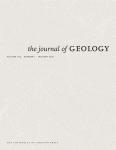 | |
| Discipline | Geology |
|---|---|
| Language | English |
| Publication details | |
| History | 1893-present |
| Publisher | University of Chicago Press for the Department of the Geophysical Sciences, University of Chicago (United States) |
| Frequency | Bimonthly |
| 2.015 (2017) | |
| Standard abbreviations | |
| ISO 4 | J. Geol. |
| Indexing | |
| ISSN | 0022-1376 |
| Links | |
The Journal of Geology publishes research on geology, geophysics, geochemistry, sedimentology, geomorphology, petrology, plate tectonics, volcanology, structural geology, mineralogy, and planetary sciences. Its content ranges from planetary evolution to computer modeling of fossil development, making it relevant to geologists as well as other researchers working in the Earth or planetary sciences.
It was established in 1893 by Thomas Chrowder Chamberlin.
